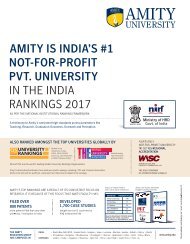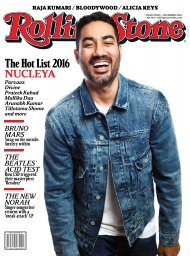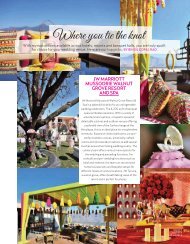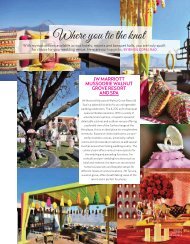SR December-15 issue pdf
You also want an ePaper? Increase the reach of your titles
YUMPU automatically turns print PDFs into web optimized ePapers that Google loves.
Clockwise from above: Francesco Clemente<br />
inside his installation, 'Pepper Tent', at<br />
Aspinwall House in 2014; In 2012, artist<br />
LN Tallur took advantage of the biennale’s<br />
huge venues to create this inverted roof<br />
installation with Mangalore tiles, some of<br />
which had tiny figures in hatha yoga poses;<br />
Visitors viewing Marie Velardi's 'Future<br />
Perfect, 21st Century'<br />
THE VENUES’ GLORIOUS PAST<br />
David Hall, a whitewashed long<br />
bungalow with blue windowpanes, was<br />
erected in 1695 opposite the parade<br />
ground in Fort Kochi. Built by the Dutch,<br />
it was once home to the Dutch military.<br />
Till half a decade ago, Fort Kochi was<br />
known for such dilapidated colonial<br />
structures, which cached history of this<br />
port town’s lost glory. Aspinwall House,<br />
another imposing structure built in 1867<br />
by an English trader, was once a<br />
storehouse for pepper, turmeric,<br />
cardamom, timber and<br />
all that this rich town<br />
had on offer. And,<br />
Pepper House, a gigantic<br />
16,000 sqft warehouse<br />
with two historic<br />
dockside godowns, is<br />
where these goods and<br />
spices were loaded onto<br />
ships. What remained of<br />
these buildings were<br />
crumbling walls, mossy<br />
roofs and termiteinfested<br />
doors and<br />
windows that creaked<br />
threateningly. India’s<br />
first art biennale, named<br />
after the lost port of<br />
Muziris, helped restore<br />
14 such rundown<br />
KOCHI-MUZIRIS<br />
BIENNALE 2016<br />
DECEMBER 12, 2016 -<br />
MARCH 29, 2017<br />
This year, the biennale has<br />
outdone itself by choosing<br />
to bridge the divide in<br />
artistic categories by<br />
bringing in 97 artists from<br />
across the fields of art and<br />
culture. Curated by eminent<br />
artist Sudarshan Shetty,<br />
and titled ‘Forming in the<br />
Pupil of an Eye’, the third<br />
edition of the biennale<br />
will also feature poets,<br />
musicians, performance<br />
artists and movies. The<br />
main exhibition is spread<br />
across 11 venues between<br />
Fort Kochi, Mattancherry<br />
and Ernakulam.<br />
buildings and made them the venue for<br />
art exhibits and installations.<br />
Furthermore, what began as a partially<br />
government-funded enterprise later<br />
garnered the support of patrons,<br />
businessmen and artists from across the<br />
world. Five years after the first edition of<br />
the biennale, art is not restricted to<br />
galleries or museums. It has crawled out<br />
of rooms and into open spaces, where it is<br />
on display for one and all.<br />
ART ON THE STREETS<br />
Chinese fishing nets introduced by<br />
Chinese-Canadian artist Zhang He,<br />
against the dramatic skyline, is the<br />
opening image of Fort Kochi. From here,<br />
a mesh of parallel roads takes you to airy<br />
cafes and timeworn stores that sell<br />
jewellery and spices. As<br />
you walk past, you find<br />
faces on the wall. Here,<br />
the walls talk and even<br />
boulders take on the role<br />
of canvasses. In black<br />
and white and bursting<br />
pop colours, a lot of the<br />
graffiti took shape<br />
during the first edition<br />
of the biennale. The<br />
graffiti has made art<br />
accessible and is an<br />
apparatus to reclaim the<br />
charm of a forgotten<br />
city. Early in 2014, a<br />
series of anonymous<br />
graffiti speckled Fort<br />
Kochi walls overnight.<br />
The ‘Guess Who’ series,<br />
122 ||||| DECEMBER 2016


















